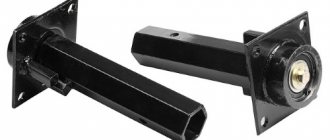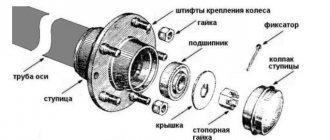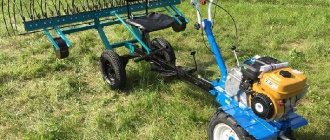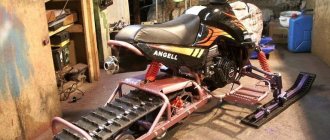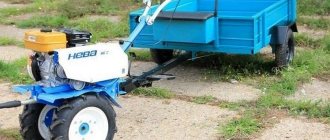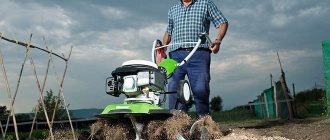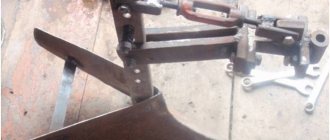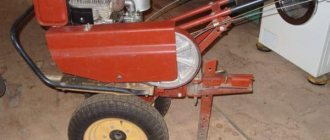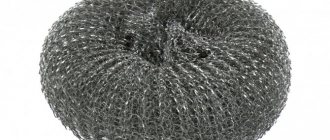Motorized cultivators have recently been in great demand among agricultural workers. As for the differential for a walk-behind tractor, it is an integral part of the design of the vehicle’s power drive. This is an element with several wheels that are located on the same axis. Despite the fact that initially this part may seem quite complicated, it is not only easy to repair, but you can make a differential for a walk-behind tractor with your own hands. There are many diagrams and drawings that are successfully used by both specialists and beginners in this matter.
How to make a differential for a walk-behind tractor with your own hands
Motorized cultivators have recently been in great demand among agricultural workers. As for the differential for a walk-behind tractor, it is an integral part of the design of the vehicle’s power drive. This is an element with several wheels that are located on the same axis. Despite the fact that initially this part may seem quite complicated, it is not only easy to repair, but you can make a differential for a walk-behind tractor with your own hands. There are many diagrams and drawings that are successfully used by both specialists and beginners in this matter.
Differentials for cultivator
Typically, the movement of cultivators is linear, so they use a rigid drive on both wheels. However, when hilling beds, turns are made frequently, and a rigid drive can make work difficult. In this case, it becomes necessary to use a differential for the cultivator, which is easy to make with your own hands. The differential for a walk-behind tractor has no design features compared to the differential for a walk-behind tractor, so the same schemes can be used. The simplest homemade product is a differential, consisting of a bushing with a transverse axis secured with a bolt. This design allows you to adjust the rotation angle from 120° to 240°, which is optimal for small-sized motor cultivators.
Why does a walk-behind tractor need this element?
The walk-behind tractor wheel, which follows an outer arc when turning, must travel a longer distance. And here the need arises for a differential or other mechanism for distributing power, which will avoid slipping. If the wheel device does not have this element, this will cause straightening of the movement. Moreover, the greater the distance between the wheels, the more difficult it will be to turn.
The main part of the work that is carried out on the ground, for example, cultivation or fertilization, is carried out in a straight line. But this does not mean that the device will never turn. Of course, the standard version of a walk-behind tractor with a rigid 2-wheel drive makes it quite convenient to use in most agricultural work. But if frequent turns are necessary, the problem with slippage and control will have to be additionally solved. If special mechanisms are not used, the vehicle will be braked by lugs. Such work will be difficult even for a person with great physical strength.
Most often, experts choose to use overrunning clutches as a solution to this issue.
These are simple and universal installations that allow you to correctly distribute the load between the wheels if you need to turn the walk-behind tractor. The versatility of this method lies in the fact that overrunning clutches can be used not only on a rigid axle, but also on a connected one. In this case, when turning, the wheel will tend to rotate faster than the front shaft. This makes it possible to conveniently operate the machine and work even in small areas, as the device becomes more maneuverable.
Universal option
The universal hitch for walk-behind tractors is distinguished by the fact that it is suitable for most models. Drawings for its manufacture are very easy to find. The hitch on the walk-behind tractor consists of the following parts:
- Two U-shaped brackets, identical in size. One bracket has 6 holes for M12 bolts, the other has 8.
- The body is a complex part consisting of several parts. Assembled by welding. Requires careful placement of holes. It has one M16 and one M12 thread, as well as a movable connection with one of the brackets.
- Inside the housing is a position adjustment mechanism consisting of a screw that connects to the handle and bracket. The most difficult part to manufacture the entire mechanism is the handle, which has several small additional elements.
Almost all parts are quite easy to turn on machines. For example, to create staples, 2 channels of suitable size will be useful. You need to make holes in them, and the brackets for the walk-behind tractor are ready with your own hands.
How to properly connect a walk-behind tractor to a trailer? The hitch is attached to the walk-behind tractor with pins. The pins must be made of steel no less strong than the hitch itself. Pins or studs are threaded through the holes.
The connection unit is usually located behind the main unit or under the steering wheel. Some connection features must be specified by the manufacturer of the walk-behind tractor or trailer.
A do-it-yourself walk-behind tractor hitch can be useful not only for connecting a walk-behind tractor plow, trailers, irrigation systems and other similar devices, but also for mini tractors and other small rural equipment.
Before starting work, you should check the reliability of the unit and tighten all the screws and nuts. If necessary, you need to change the position of the movable joint. To do this, you need to turn the screw handle in the desired direction. This will allow you to lower or raise the trailer. In some cases, some fastenings will need to be loosened.
After completion of work, threaded connections should be cleaned and lubricated to prevent corrosion and premature failure.
Simple design for a walk-behind tractor
Many farmers, when using conventional equipment, often think about how to make a differential for a walk-behind tractor with their own hands. A similar idea may come to a repairman if an old element breaks down. There are no particular difficulties in making a differential for a walk-behind tractor with your own hands. But first, you should stock up on a suitable diagram or prepare drawings.
Those who are thinking about what type of differential to choose for a walk-behind tractor should remember that this type of equipment does not require prolonged rotation of the wheels relative to the axis. That is why you can choose the simplest options.
Often, universal differential systems are used for walk-behind tractors. They allow the wheels to deviate from the axis by a certain degree.
In the simplest version, you need to take a bushing with a transverse slot and insert a short axle into it. The last element must be fixed with a bolt, and only then attached to the wheel structure. This system works quite simply. The drive axle must turn the bushing all the way, that is, until it hits the bolt. It is worth noting that with this element the master can initially set the most suitable wheel rotation angle for him, which also depends on the size of the slot.
The peculiarity of this detail is its maximum simplicity. You don’t have to be an experienced craftsman or mechanic to make such a differential for your walk-behind tractor. You just need to have certain skills in operating a machine. This will be enough to obtain the basic elements needed to make such a differential.
Making a hub - step-by-step algorithm
As in the case of a differential, to manufacture a hub for a walk-behind tractor, you will need to prepare drawings. A detailed diagram will make it possible to complete the work faster and avoid common mistakes.
The correct sequence of actions when making a hub is as follows:
- First you need to grind the workpiece. To do this, any metal part is taken and processed on a lathe;
- A fairly popular option is to make a flange and then weld it to a metal pipe or rod. When processing a part, you should be extremely careful and observe the dimensions indicated in the selected drawings;
- It should be remembered that during operation the hub will be subject to constant loads, which is why it is better to choose a reliable material for making it yourself - for example, hardened steel.
After manufacturing the hub, it can be installed on the walk-behind tractor and tested in operation. You should not place high loads on the part immediately after installing it on the unit - otherwise it may become deformed. It is best to walk with the walk-behind tractor several times on a flat surface in the yard, turning the car around several times. After this, the hub will finally fall into place, and the unit with it can be used for work in the garden.
A self-made differential or hub can be successfully used to equip Neva brand walk-behind tractors. The design of the units of this brand allows you to easily install the part, and, if necessary, remove it easily and quickly.
Advantages and disadvantages
The main advantage of this method of solving the problem of turning wheels is the simplicity of the design. In addition, such a differential is universal, as it is suitable for almost all types of walk-behind tractors.
But the semi-differential also has its disadvantages. Here, first of all, you need to note the small angle of rotation that will be available after installing such a structure. This type of mechanism does not allow rotation of more than 240º. Many farmers note that the presence of a transverse groove makes the structure not very strong. If the load is significant, the axle may break. Therefore, those who decide to use their own made differentials for a walk-behind tractor should be prepared for the fact that the structure will periodically have to be repaired and remodeled.
Considering all the pros and cons, we can say that for those who are not too demanding of their walk-behind tractor and lightly load it with straight and rotary work, a semi-differential is perfect. For serious loads, it is worth looking for more durable structures.
General Tips
Let's start with the simplest option in the form of an axle extension with a transverse groove . It will be quite reliable even if made from affordable mild steel.
Axle extension
It is better to use a bolt connecting the components of the extension with an internal hexagon head and mill a groove with a width equal to its outer diameter.
In this case, firstly, there are no protruding parts capable of wrapping grass around itself, and secondly, a bolt tightened all the way will not become loose over time.
The gap between the bushing and the extension axle cannot be made too small , since if corrosion occurs they will become acidic to each other. It is highly advisable to place a grease fitting on the bushing for in-place lubrication of the structure.
The more complex rotary hub design can also be made from mild steel as it is easily welded.
Finishing of the bearing holes in the hub must be done after the flange and rotation angle limiter are welded due to the inevitable warping of the part during welding.
Making a differential for a walk-behind tractor yourself cannot be called a technically difficult task, and this is proven both by the experience of many owners of garden equipment and by the fact that common offers in online stores copy originally handicraft designs.
How to make a differential for a walk-behind tractor
Auto mechanic, specializes in agricultural equipment
Modern special equipment has made it possible to take agriculture to a new level. Currently, there is no need to cultivate the land manually, since auxiliary equipment exists for this. However, like other specialized devices, this type of equipment such as a walk-behind tractor does not last forever, which is why these devices have to be repaired in a timely manner. Often the load distribution system fails.
A differential for a walk-behind tractor is a device that allows you to evenly distribute power between the wheels. Due to constant heavy load, the device may fail, which requires timely replacement.
You can make a differential for a walk-behind tractor yourself
Making a field sprayer
A homemade sprayer for a walk-behind tractor is necessary in cases where the area of cultivated crops exceeds 20 acres. Doing this type of work manually is very difficult and can take a whole day. Mechanization of this process will save a lot of time and effort.
To make a sprayer you will need:
- welding machine;
- Bulgarian;
- level;
- electric drill;
- soldering iron for polypropylene pipes;
- profile or round water pipes;
- plastic or steel barrel with a capacity of 80-100 l;
- wide pneumatic wheels;
- plastic pipes;
- rubber hose;
- injectors or nipples from wheel tubes.
Assembling a homemade sprayer is carried out in the following sequence:
- Making the frame. Its dimensions are adjusted to the size of the container. The chassis is attached to the frame. For good cross-country ability you need at least 4 wheels. In the absence of wheels, wide skids are made of aluminum.
- The container is installed and secured on the frame. For this purpose, spacers and ties are used. Holes are made in the tank for supplying high-pressure hoses. The tank neck is sealed.
- A bracket for the pump is being manufactured. A model is selected that operates from a power take-off shaft (belt drive) or from electricity (motoblock generator).
- The irrigation system is being assembled. A durable holder is made from steel profiles. Plastic pipes are attached to it using clamps or plastic ties. A valve is being installed to bleed off excess pressure and injectors.
- All parts are connected together, the quality of the fastenings and the tightness of the joints are checked. The tank is filled with water, the unit is tested in various modes, and final adjustments and settings are performed.
A self-made sprayer will fully justify the efforts invested in the first season. Thanks to this device, spraying and watering the garden will be done quickly and efficiently.
Purpose of this element
Before you familiarize yourself in detail with the varieties, manufacturing options and mounting method, you need to consider why a differential is installed on a walk-behind tractor, namely:
- The main function of this device is to distribute power between the wheels of special equipment.
- At the moment of rotation of the wheel relative to the axis, this mechanism does not allow the element passing along a smaller radius to slip.
- A load is regularly placed on the differentials, provided that rotation of the wheels is created relative to the axis in a different projection (when cornering).
- The device allows you to process a relatively large mass (the load that appears when the direction of the axis changes).
Materials and tools
The hitch on a walk-behind tractor consists of several rather complex parts. First of all, you need to find drawings that are suitable for creating a unit. This is the most important condition. The drawing must be working and verified.
The materials that will be needed in the future during assembly are as follows:
- Metal blanks - narrow plates, channels. The main part of the connecting assembly will be welded from them.
- Bolts and steel studs are the main fastening elements that allow you to create a fixed or movable connection in an assembly.
- The adjustment element is a lever that helps change the position of the attached device.
For assembly you will need the following equipment:
- metal welding;
- metal drill for creating holes;
- ruler for measurements;
- a set of wrenches for tightening screw connections.
Depending on the dimensions of the equipment, the hitch for a walk-behind tractor will have its own characteristics and fastenings. The larger the equipment itself and its load capacity, the stronger and larger the connecting unit will be needed.
Types of power distribution mechanisms
Since soil cultivation devices have a relatively large mass, which makes them almost impossible to deploy manually, an appropriate mechanism is installed here to distribute the power. Typically, the following devices are used:
- A rigid drive that delivers uniform power to two wheels at once, since most of these devices are two-wheeled; to turn, you just need to tilt the block in a certain direction, after which one wheel adheres more tightly to the ground, which is why a turn occurs.
- Also, modern differentials for equipment such as a walk-behind tractor often include such a simplified mechanism as an overrunning clutch, which allows increasing torque for one of the drive wheels, which is achieved due to increased traction compared to conventional axle rotation.
- Also, to solve the problem, a classic gear differential can be used, which allows you to provide power and torque in an inversely proportional ratio, depending on the need (for example, when turning, one axis receives increased torque, and the other receives an inversely proportional load).
There are several similar mechanisms, or rather their types.
Depending on the version of the mechanism used, an appropriate solution is provided that allows for conditions for free turning on the ground, where there is enhanced adhesion to the surface.
Important! A differential for a walk-behind tractor, such as an overrunning clutch, can be made independently with your own hands, but this requires knowing the characteristic features of the design of this equipment, as well as using a diagram that can be found freely available on the Internet.
Simple homemade agricultural structures
How to make a differential with your own hands? The easiest way to construct a homemade differential is as follows. You need to attach a bushing that has a transverse slot to the walk-behind axle. You need to place a short axle inside the bushing, and you can secure it from falling out using bolts inserted into the “body” of the bushing through a slot. The wheel itself is fixed on the axial side.
During operation of the walk-behind tractor, the drive axle easily rotates the bushing until the reverse slotted side presses against the bolt.
When turning the wheel, the wheel, trying to “get ahead” of the drive, pushes the bolt forward along the hole. Thus, the transmission of the turning element is “broken.” The angle of easy turning of agricultural machinery depends on the slotted length. This extension mechanism is very simple. It is quite possible for a junior specialist level turner to make it. That's why these extension cords are so popular and relatively inexpensive. As a rule, they are made with a couple of holes. Due to this, the track width can vary and connect the drive axle to the wheel.
The need for this constructive mechanism
Before considering the process of making a differential for a walk-behind tractor with your own hands, you need to understand the need for this device. Let's consider the main points that apply to these parts of the power unit:
- first of all, it should be noted that this particular device is designed to obtain torque, which is transmitted from another power plant present on special equipment;
- It should also be understood that the differential on a walk-behind tractor, made with your own hands or at the manufacturer’s factory, is designed to transmit torque to the rotating axles;
- additionally, this mechanism is a constructive mechanism for distributing power, which is produced by the power plant of special equipment, and is subsequently transmitted to the main axis of the vehicle;
- it is important to take into account the fact that due to the differential mechanism, an effect is achieved that allows the mechanism for soil cultivation to freely enter turns and turn around;
- the use of overrunning mechanical components helps prevent slipping of one wheel, which can occur due to the uniform transmission of torque to one side.
Based on this, we can conclude that this structural mechanism on special equipment is extremely important, which significantly simplifies the procedure for cultivating the land, since without these mechanisms you have to manually deploy a heavy power plant, which not everyone can do.
Important! Another characteristic feature of this mechanical component is the ability to create inverse proportional traction, which makes it possible to significantly slow down one of the sides during sharp turns or completely supplement the wheel with reverse rotation, as a result of which the maneuver is performed much easier and faster.
Construction portal No. 1
A hitch for a walk-behind tractor will be needed to connect a trailer, plow, hiller and other device necessary for cultivating the land. Almost all walk-behind tractors come without additional parts, such as hitches, so they have to be purchased separately. Unfortunately, it is not always easy to find a suitable connecting node, so you have to get out in every possible way. If you can’t find something suitable, the only option may be to assemble a hitch for a walk-behind tractor with your own hands.
DIY constructive mechanism
To personally make a homemade differential for a mechanism such as a walk-behind tractor, you should pay special attention to the work. In this case, it is necessary to consider in detail the entire algorithm of actions for the manufacture of such parts:
- First of all, it is necessary to take into account the design features of the equipment used (special equipment).
- It is also important to choose the optimal installation option that suits the design features of the technical device.
- You need to download and print a diagram with exact dimensions or make it yourself.
- Next, all the elements for the manufacture of such a mechanism are selected separately (hubs, for walk-behind tractors, gears, camshaft and other components).
- Next, you also need to choose the option of manufacturing such a device as a differential for special equipment.
- Study in detail all the materials regarding how such a mechanism is performed in practice with your own hands.
- After studying the theory and preparing the necessary components, you also need to select the tools.
- During the assembly process, it is also recommended to use the appropriate video instructions that are available on the Internet.
- All prepared elements must first be adjusted to a single size that is used on the walk-behind tractor.
- Subsequently, according to the instructions, all structural components are assembled together.
- At the end, the part is checked for functionality, and only after that it is installed on the axle of special equipment.
Assembly at home
A do-it-yourself hitch for a walk-behind tractor can be made even outside of production. To create a high-quality product you will need good material, or rather, durable metal. Even channels can be used as a basis, since they have a sufficient margin of safety and are made using factory technology. You only need to make a few additional holes, and your homemade hitch will be partially ready.
This entire device can be made of durable steel or cast iron. But since such materials require special equipment for processing, it is better to buy or look for industrial blanks. If there are special workbenches, you can give the steel blank the required shape, which will cost much less.
You can use car parts as such an element. A cardan, for example, can make a good hitch for a walk-behind tractor trailer if it is properly strengthened. For each individual brand, the towbar for a walk-behind tractor will be slightly different, but there are several universal options that can also be used for a mini tractor.
conclusions
The differential for a walk-behind tractor is an irreplaceable component that allows you to reduce the physical stress on a person that is experienced when the vehicle enters a turn. This device is also responsible for the uniform and proportional distribution of torque on the axle, which allows you to control such a vehicle when cultivating the soil.
If the original parts do not provide the required effect, then the owner of the equipment can independently manufacture the device to suit his requirements, and then install it on the walk-behind tractor and operate the special equipment with greater comfort.
General recommendations
Here are some tips for farmers on how to assemble an excellent homemade differential for a walk-behind tractor:
- The gap between the extension axle and the bushing cannot remain too small. If the corrosion process begins, they will “stick” to each other;
- To lubricate the agricultural device without preliminary disassembly, it is a good idea to place a grease nipple on the bushing;
- Extensions can be constructed from low carbon steel. The unit will be strong, reliable, and at the same time quite inexpensive in cost.
Differential for a walk-behind tractor - how it works and what it’s capable of
Diary entry created by user CaimanTeh, 02/26/15 .808,
Recently, a video of the Caiman Vario walk-behind tractor with a snow thrower attachment was posted on YouTube. During the story about the features of winter use of the walk-behind tractor, “additional differentials” installed on the wheels were mentioned.
To demonstrate the differentials, Denis turned the walk-behind tractor back and forth. The demonstration was short, but this option interested the participants in the Pubert & Caiman Motor Tillers
In the topic, it seemed like they quickly figured out what these additional differentials were for a walk-behind tractor, but since the question arose, I decided to make a short photo report. After filming, the demonstration walk-behind tractor with a differential was full of gasoline and oil, so it was taken to the service room. It's cramped there, there's a lot of other equipment around, so we couldn't spin it. All I got from Caiman Vario was a photograph.
Differential for Caiman Vario walk-behind tractor
So, here are these differentials, or rather semi-differentials installed together with standard rubber wheels of size 4.00-8. (The set of two semi-differentials is called “Differentials with extensions for the VARIO/Q Junuor/Q Max walk-behind tractor” and has code R0101.)
How it's done
The design of such differentials for walk-behind tractors (and walk-behind cultivators, by the way) is extremely simple:
- the wheel hub is not secured to the axle
- there are protrusions on the axle and hub (indicated by green arrows) that prevent the wheel from turning a full turn
How it works
During normal movement of the walk-behind tractor, the protrusion on the axle rests against the protrusion on the hub and transmits rotation to the wheel. In this case, both wheels will rotate simultaneously.
But if you push the walk-behind tractor forward, the differential hubs will work as overrunning clutches, and the protrusions on the wheels will “run away” from the protrusions on the axle. They won’t be able to run far - having made almost a full turn, the protrusion on the hub will touch the protrusion on the axle, but this will be enough to complete the maneuver.
After completing the turn, the walk-behind tractor with the differential will be able to move only at the expense of one wheel until the protrusion on the axle of the second wheel “catch up” with the protrusion on the hub. It is also possible to slip one wheel until the “unlocked” one comes into working condition.
Why do we need differentials for a walk-behind tractor?
To put it simply, the walk-behind tractor needs differentials to turn at the end of the furrow. This is how the same Caiman Vario turns around on lugs and without differentials.
To turn the walk-behind tractor and return to the cultivated area, the lugs have to be dragged along the ground. And here it all depends on the weight of the walk-behind tractor (or cultivator) and the strength of the operator.
At the end there will be a video showing how much differentials make this task easier.
Differentials on the Pubert Quatro Junior walk-behind tractor
Above was a picture with a differential hub different from that installed on the Caiman Vario - in the showroom there was another walk-behind tractor with a similar design of differentials.
Differentials on the Pubert Quatro Junior walk-behind tractor
Unlike previous domestic differentials suitable for several models, these are part of the native French “Plowing Kit” (code 8000010205) for the Quatro Junior and QJ V2 models (Caiman, Pubert and MasterYard, including models with a diesel engine) which includes includes:
- differentials
- wheels 5.00-10
- weights
- reversible plow
Quatro Junior with this kit has a wide track and weighs over 100 kg. In order to turn it around with its wheels locked, you need to be either very strong or very stubborn. In any case, such a turn at the end of each furrow will take a lot of time and effort in total.
Differentials, unlockers, overrunning clutches, etc.
Yeees! But without diffs I drove five times or more. I can’t say for sure, I don’t have a speedometer
Well, any diff is connected to the wheels or gearbox using holes and bolts. I think they won't break much less.
And another minus is the large camber of the wheels due to additional play in the diff itself. This of course does not apply to serious diffs.
I am more tormented by the question: How does the gearbox feel better, with or without a diff?
ZeVic wrote: I am more tormented by the question: How does the gearbox feel better, with or without a diff?
If the design of the differential causes dynamic shocks on the output shaft of the gearbox, then I think it will be easier for the gearbox without a differential.
Yes. But on the other hand, there are the typical twisting moments on the output axis of the gearbox when turning.
Once upon a time, your sales consultant at Budyonny did not recommend differentials for Salut. He said that this is an additional load on the gearbox. He referred to specialists from the factory.
ZeVic wrote: Yes. But on the other hand, there are the typical twisting moments on the output axis of the gearbox when turning.
Example (probably not a good one?)
Try pushing a nail into a board with a hammer without swinging it.
(Static load) And by swinging a hammer, a craftsman will drive a nail into the board with one blow. (Dynamic load uses inertial forces)
After all, probably something similar can occur in the axle assembly of a motorcycle if you use the described differential principle.
ZeVic wrote: Once upon a time, your sales consultant at Budyonny did not recommend differentials for Salute. He said that this is an additional load on the gearbox. He referred to specialists from the factory.
Some kind of nonsense. Think for yourself, if you use a real one, it can only have a beneficial effect on the life of the gearbox!
UV wrote: Some kind of nonsense. Think for yourself, if you use a real one, it can only have a beneficial effect on the life of the gearbox!
Actually, I thought so too. They probably meant an increase in the load on the gearbox simply by lengthening the differential shaft.
UV wrote: How does the pseudo-dif behave and help when turning? In theory, dynamic shocks should occur in the node, how strong are they?
Drives excellently when cornering. There are impacts, but not significant. Worked on plowing, total weight with additional load MB
kg 230 there were no problems. Without additional loading the blows are stronger. I don’t use it as a transporter yet.
ZeVic wrote: But on the other hand, there are non-Detish twisting moments on the output axis of the gearbox when turning
Try to turn a 230 kg MB with a GZ without a differential - it’s the same as lifting a horse and turning it around.
ZeVic wrote: He said that this is an additional load on the gearbox.
I agree, but during a turn. The load will be on one axle, so in other switchable locking schemes the same canoe, but factories do it. Actually, this is a simple way of unlocking and I’m already used to it, the main thing is that it helps with the work, and whatever inconveniences arise, you get used to it. I don’t like racing. And the belt clutch softens the impact on the engine - it doesn’t feel it, judging by the sound of the engine. Cheap and cheerful. It’s not possible to find something suitable here, except for UAZ locks, but at a price of 5 thousand, and you need two of them - the total cost is half a MB and why the hell do you need it. Go for it. Good luck.
These are the kind of axle unlockers with steel balls that the Japanese made in Honda walk-behind tractors already in the 1970s.
And they are trying to make an unlockable axis based on balls in Russia, but at the present time. » >
And an unlock option with a plug
Alvis wrote: A weak point in the unlockers was revealed: at the end of the autumn work, the clutch fingers were twisted and torn off. This unit will need to be strengthened.
I remade the clutch fingers to be more durable and the surface of the fingers was charred, that is, metal sementation was carried out
Thanks to 52dim, thanks to him I bought this device on Zubrik
Express your pros and cons.
Agrowest wrote: I bought this device on Zubrik. Express your pros and cons.
If this "finger"
made of St3 steel and dimensions about 10x10, then it can be rolled up.
Alvis wrote: then he can fold it.
The device of a differential overrunning hub for the wheels of a homemade walk-behind tractor
Considering that the walk-behind tractor always works on uneven, hilly terrain and its wheels travel different distances, this discrepancy between the wheels of the walk-behind tractor must be somehow eliminated. The role of a differential on a walk-behind tractor can be performed by an overrunning clutch, the device of which is shown in the drawing. A drive sprocket is welded to the wheel axle, a ball bearing assembled with the housing and a ratchet overrunning clutch are installed. The principle of operation of the ratchet overrunning clutch of a walk-behind tractor wheel is based on the transmission of rotation through a spring-loaded pawl that engages with the ratchet tooth of the walk-behind tractor wheel hub. When the rotational force transmitted from the engine to the wheel is stable, it compresses the spring of the overrunning clutch pawl and it is engaged with the hub ratchet tooth - torque is transmitted to the wheel. As soon as the force weakens for any reason (the wheel hits an obstacle or the walk-behind tractor is turning), the overrunning clutch spring opens and the pawl jumps to the next tooth of the walk-behind tractor hub ratchet, causing the wheel to slip in place. The drawing of the overrunning ratchet clutch of the differential wheel hub of a walk-behind tractor shows: 1 wheel axle of a walk-behind tractor, metal shaft; 2-drive sprocket; 3, 4, 5, 6 - wheel axle ball bearing assembly; 7- overrunning ratchet clutch of the wheel hub; 8- axis of rotation (installation) of the ratchet clutch pawl; 9- overrunning clutch pawl; 10- ratchet of the differential clutch of the walk-behind tractor; 11 — two ball bearings (No. 307); 12- two spacer washers for ball bearings; 13- wheel of a homemade walk-behind tractor; 14- spring of the pawl of the overrunning differential clutch of the walk-behind tractor wheel
Types of wheels
First you need to figure out what types of wheels for walk-behind tractors exist. Since the equipment is used in many farming processes, the equipment varies. This also applies to pneumatic wheels, because good results and ease of use also depend on the right components. It is important to note that ordinary car wheels from Oka, Niva or Moskvich cannot be installed on the walk-behind tractor. All of the options below are larger and heavier. It would be more correct to compare them with ATV kits, although they do not always have the appropriate size.
- Pneumatic. This option can be used for arable work and for removing roots from the soil. These are large wheels in appearance, with a diameter of 40 cm and a width of 20 cm. The tread pattern must be rough for the walk-behind tractor to work well on the soil. Often this option comes as standard and is famous for its wear resistance. However, if they become unusable, you should immediately look for a replacement.
- Traction. The popular name for these wheels is herringbone. All because of the pronounced pattern on their tires. This type is also universal and suitable for lug or standard transport solutions. For example, they are often used by snow blowers. Traction tires for walk-behind tractors are also reliable in everyday use.
- Solid cast (most often made of rubber). Solid castings are ideal for rocky ground. They allow the walk-behind tractor to move faster on such terrain and do not deteriorate after the first use. The downside is that they are really very heavy, so carrying them is not so easy. Such tires are suitable for MTZ series walk-behind tractors and diesel vehicles.
- Metal. The last variation is suitable for clay soil. The thing is that, unlike previous wheels, these have steel teeth. This, of course, makes the equipment heavier, but in soft ground they do their job perfectly. In another way, metal teeth are also called lugs.
As for general recommendations, when choosing what to put on your walk-behind tractor, pay attention to the front wheel. It is supportive and during use it absorbs the entire mechanism. This helps to extend the service life and improve the quality of work.
In general, this classification of pneumatic wheels is used not only for walk-behind tractors, but also for trailers or other tools from the same category. So you can safely use it, because to maintain the wear resistance of all equipment, the farmer’s assortment must include both a trailer and a walk-behind tractor.
Ratchet differential of the wheel hub of a walk-behind tractor
Open photo Ratchet differential of the wheel hub of a walk-behind tractor in enlarged form. If this is a drawing or diagram of a device, you can download it to your computer by opening it in large size and using the “Save picture as” function. "(right mouse button). Please rate this material by highlighting the appropriate number of stars.
Most often, together with this material on the topic |
